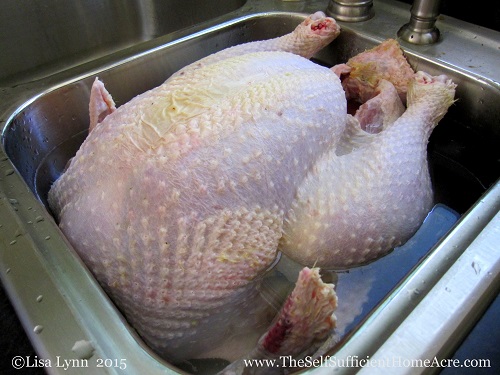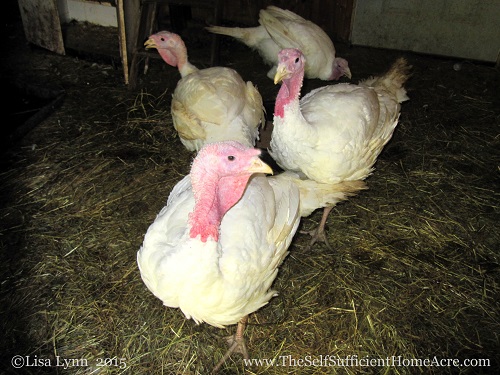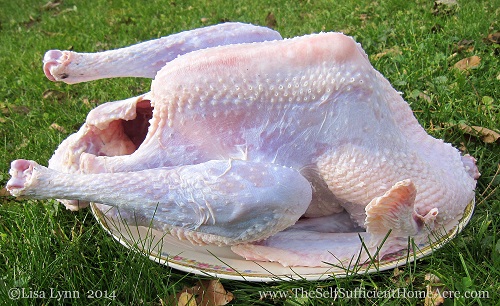
Check out my posts ‘How to Cull Your Old Laying Hens’ and ‘Butchering An Injured Hen’ for more of my thoughts on butchering.
Extreme Butchering
Butchering animals in subzero temperatures is not an ideal situation. However, life doesn’t always work out the way we plan. Sometimes an animal is injured in the frigid winter and needs to be put down. This isn’t something new. Our ancestors often had to hunt and dress their kill in the worst of weather in order to feed their families. Butchering in extreme weather may not be as prevalent on modern homesteads, but it still happens and it’s good to be prepared for the possibility.
Butchering Roosters in Frigid Weather
I had 9 cockerels ready to butcher and wanted to get it done this week. I don’t want to keep feeding them, but we’ve had an Arctic blast that has prevented me from taking care of this project. Today’s temp was supposed to reach a balmy 24 F so I processed 3 of the cockerels in a very cold barn. The wind was blowing in under the doors and when I checked the thermometer, I realized it hadn’t gotten over 18 F…so much for the heat wave! I gave in and warmed up next to our wood stove…6 more chickens to go and the weather isn’t looking any better in the near future.

Butchering Injured or Sick Animals in the Winter
I’ve had to butcher animals unexpectedly quite a few times. Usually because they are injured and rather than letting them suffer, I performed emergency butcher sessions. My poultry are livestock, not pets, and they will be eaten eventually. So I’m not willing to spend money taking them to the vet’s office. If you keep farm animals, you need to decide which ones are valuable enough to pay for emergency vet bills and which ones will be butchered and eaten. Don’t waver from your decision and it’s best not to name them Ethel and Henrietta if you intend to eat them.
My first emergency butcher session was in January of 2008 with temps at -13 F. I was raising meat rabbits in our suburban backyard at that time. (We have since moved.) One of the does developed pneumonia and it was obvious she was dying. The humane thing to do was put her out of her misery. So I processed the rabbit as quickly and carefully as I could so the meat wouldn’t go to waste. It was the first time I butchered an animal on my own…talk about trial by fire, I mean ice!
If You Have to Butcher in Extreme Cold…Be Safe
You’ll want to do everything you can to make the session as safe and comfortable as possible. Can you butcher in an enclosed building? A garage or barn will keep you out of the freezing winds. If you can’t butcher inside, choose the most protected outdoor spot you have. Set up tarps or other wind blocks if possible. You may want to start a fire next to your work space if it is safe to do so.
While you are working to process the animal, your hands will be fairly warm as long as they are inside the carcass. As soon as you pull them out, the moisture will start to freeze and your fingers will get numb if the temps are low enough. Wear a pair of rubberized work gloves, the kind that are cloth but look like they’ve been dipped in rubber. It might be a little bit cumbersome, so be careful. It is possible to cut your fingers and not even feel it when they are very cold (I can attest to this).
Use the easiest and quickest method for processing the animal. Cut large animals into chunks with a saw and bring the chunks inside to process further. Allow yourself breaks. Go inside to warm up, drink some hot tea and change into dry clothes if necessary. Watch for signs of frostbite and hypothermia. Not only are they dangerous conditions, but they will make you more likely to slip with the knife and injure yourself.
Symptoms of Frostbite and Hypothermia
- Frostbite causes the skin to become white and waxy looking, then grey and darkening (in severe cases). It may feel like the skin is burning then numb. Warm up slowly to prevent tissue damage. Don’t use hot water or get too close to fire to warm up.
- Hypothermia is setting in if you get so cold that you stop shivering. Your body is attempting to save energy and this is a serious warning signal. Drowsiness, confusion, forgetfulness, and slurred speech follow if you don’t warm up.
Do You Have What it Takes?
If you are planning to raise livestock, there is always the potential that one of them will need to be put down and butchered in winter. Are you willing to do this? Be sure you keep the supplies you need on hand so you can butcher at a moment’s notice. Do your best to set up an indoor area to process the animal out of the elements.
If you were in a survival situation, would you be able to field dress a kill in subzero temperatures? Hunters through the ages have had to survive this way. If you ever find yourself in this situation, build a fire and try to do the processing between the fire and a windbreak. This will keep you warmer than the fire alone. You can warm your hands in the innards but dry them as soon as you pull them out. It’s not an ideal situation, but if you need the meat to feed your family, you do what you’ve got to do. Play it safe and harvest just part of the animal if the conditions are dangerous.
Have you ever had to put an animal down? Tell us about your most extreme butcher session. I like to learn from your experiences!
Please note that you are taking risks if you engage in these activities. I present this information as a thought provoking exercise in preparedness and self reliance. When I butcher an animal in subzero temperatures, I do so only out of necessity and I take precautions to make sure I’m not putting myself in danger. I suggest you use common sense in these situations and stop if you feel sick, disoriented, or too cold to proceed safely.
Update: I wrote this post on Friday, January 24th after processing 3 of the 9 cockerels hatched in September. I finished the last 6 yesterday afternoon (January 26th). The outdoor temperature when I started was in the high 20s and fell while I was working. It took just about 2 hours to kill, skin, and gut all 6…about 20 minutes per bird. I made the decision to butcher rather late in the day after seeing that our temperatures were forecast to dip back down into the subzero range for today and tomorrow. The cockerels were starting to crow and were eating more feed than I cared to provide. Once they start to crow, I know it is time to butcher or their meat will get tough from all the testosterone.









Tomorrow is the day for 3 young roosters and our oldest hen – the first time I’ve ever been involved in killing our own animals! I’ve got a friend coming to do most of the work, but I’m sure I’ll get roped in to do some of it… feeling a little nervous!
Hi Donna,
You’ll do just fine. I commend you on making the decision. It isn’t easy. It’s easier to just keep buying feed for them. 🙂 Best wishes! Let me know how everything goes.
We’ve been lucky to not have to cull in the winter, but we have had to setup shop lights when we couldn’t get the job finished quick enough before nightfall, ha!
I hear you, Megan! Ya do what ya gotta do!
We took 7 excess roosters in January to our Amish friends who do processing. They close their weekly butchering after Christmas but said to bring our 7 and they would do them at the house. They used a hatchet on a wood block on the lawn then took them all to their unheated wash house attached to the house. With one bucket of hot water for scalding and another empty bucket to put the excess feathers in, two ladies had those 7 birds done in about 15 minutes. It would have taken me that long just to do one!!! They then took them into the warm kitchen to finish the gutting and final cleaning all done in a washpan on the table.. You were brave to tackle so many and in such cold weather. I didn’t realize that with testosterone production it makes them tough! – that explains a lot as mine WERE tough (6 months of age). Although I separated them from the pullets so they wouldn’t be harassed – they were constantly fighting and chasing each other around the shed – and consequently not an ounce of fat on them (not good). I’m going to stick to Cornish Crosses from now on for my meat birds and if I do any hatching of my egg layers and have excess roosters I’ll put them in the freezer early for soup or stewing and not keep them longer in hopes of a heavier carcase(which just doesn’t happen unless they are Cornish Crosses).. Funny thing but today I cooked a 4lb rooster which was in my freezer labeled from last year’s culling (not the recent January batch). I boiled it first until tender for soup, then put the large parts in a baking pan w/tomato soup & dry french onion soup mix (one of my favorite recipes). It was very tender & served with plain noodles & the sauce was delicious.
Hi Linda,
It’s nice that you have an alternative for processing your chickens. My parents had some friends from the city visiting them last summer and they went for a drive. They happened to drive past your friends’ house while they were processing chickens. I guess my parents’ friends were a little taken aback by the flopping chickens and blood! (Not sure, but I wouldn’t put it past my Dad to drive by there on purpose!)
I’m not sure that everyone would consider my actions brave! Some might say foolish 🙂
As young cockerels get closer to the age of mating, their testosterone production increases. Crowing and fighting goes along with the increase in hormones. Before the creation of the Cornish X hybrids, more people caponized their young cockerels by removing their testicles. Doing this stops their testosterone production and has the same effect as castrating male calves, colts, and any other animal. Unfortunately for the cockerels, their testicles are located deep within the body cavity, close to the spine, making it necessary to create an incision between their ribs. The incision is spread slightly and the testicles are removed. The process is very invasive and takes a lot of practice. The better you get, the fewer cockerels you’ll have dying from a botched surgery. The practice isn’t as widely used now that we can get the same results by raising the Cornish X hybrids.
I also boil any chicken that I think will be tough (roosters and stewing hens). Sometimes I pick the carcasses clean and use the meat in casseroles or other dishes that cook for longer periods with a sauce. They are much more tender that way and your dish with tomato soup, onion soup mix, and noodles sounds yummy! Thanks for the idea!
That’s a great tip about tough meat when testosterone kicks in with crowing! Thanks.
Hi Nancy,
Yes, they start putting their energy into fighting over the ladies instead of getting fat and tasty. 😉 I usually try to butcher earlier, but gosh, we’ve had so much frigid weather! I was having a tough time getting it done. Thanks for visiting!
Butchering in below freezing temperatures had to be rough. I’m thinking brutal. I’ve never butchered anything but rabbits and chickens and then only in true balmy conditions. You get 5 stars for this one.
Hi Toni,
It isn’t so bad if you have an enclosed space to stay out of the wind. I finished the cockerels yesterday afternoon, since our temps were forecast to dip back down into the subzero range. I should update the post. 🙂 I think the fact that you are willing to butcher your animals at all gives you some pretty big stars on your homesteading badge of honor! Thanks for stopping by!
I have processed several deer in those conditions and actually prefer cold or freezing temps to do so. Haven’t done any chicken but look forward to trying. ;o)
That’s great! Thanks for sharing 🙂